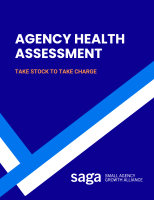Weekly 1:1 meetings between managers and their direct reports can make a bigger difference in the success of an agency than almost anything else that they do.
That’s a bold statement – and one that I make often – so let me explain.
The primary asset for just about any public relations or marketing agency is its talent. Agencies frequently tout their teams as the “difference” between them and their competition, but the reality is that it isn’t the differentiator. The people are the product.
It stands to reason that the most significant asset of any business should receive regular attention to make sure that it is working properly.
Farmers regularly check on their crops to make sure that they are well-fed, watered, and free of insects and disease. Airlines regularly inspect their planes to make sure that they are safe, reliable, and comfortable(-ish) for passengers. Manufacturers inspect their machinery and the products before they get shipped to market.
Agencies need to do the same by routinely checking in with their employees.
What 1:1 meetings do
Weekly 1:1 meetings can be an outstanding tool to ensure that your team has the information that they need to be effective.
These conversations can uncover early signs of issues with clients, other managers, or even the team members themselves.
As communications professionals, we often focus so much on speaking with our clients and the outside world that we forget to look within.
Regularly holding 1:1 meetings with our direct reports (and ensuring that all of our managers do the same) can help to bridge that communication gap.
A consistent routine of 1:1 conversations also helps to improve performance by providing a regular system of mutual feedback. This means that annual performance reviews shouldn’t surface new issues but should merely summarize these ongoing discussions.
Why many agencies don’t hold regular 1:1 meetings
Since I talk so much about 1:1 meetings, I have heard just about every kind of pushback possible. None of it holds water, so let’s walk through a few of the more common excuses, and I’ll knock them down.
“It would take too much of my time to have 1:1’s every week.” That argument is usually a sign that the owner (or other manager) has too many direct reports. If you have more direct reports than you can count on one hand then you have too many. If you have 5 or fewer employees reporting to you, then you could do one a day for 30 minutes or less. That’s a worthy investment of your time.
“I already talk with all of my direct reports daily.” While that may be true, there is a fundamental difference between a regular weekly 1:1 meeting and those daily interactions. The daily conversations tend to be around specific tasks or clients. A well-run 1:1 opens the door to addressing other opportunities and challenges that might not make it into those interactions.
“I have an open door policy so employees already know that they can come to me with anything.” This is a great theory – and one that I have implemented myself – but it relies upon the employee to decide that something rises to the level that they need to walk through the door or hit you up on Zoom. The reality is that a weekly 1:1 gives them a forum to talk about things that they might not feel warranted a separate conversation.
“I’m trying to encourage fewer meetings, so this runs against that approach.” While it is common to complain that there are “too many meetings,” the reality is that there are too many poorly-run meetings. Well-structured meetings that have clear agendas, goals, and follow-up can actually increase productivity. That’s especially true of 1:1’s with direct reports.
“I try to do weekly 1:1’s but we always end up needing to postpone due to client work.” You need to recognize that your team is just as important as your clients. Weekly 1:1’s should never be canceled, though you can obviously reschedule if absolutely necessary. If client work continues to consistently interfere then you may have an issue of being understaffed (and likely underpriced) and you should address that quickly before it becomes an even bigger problem.
Overcome the obstacles and start 1:1’s now
Whatever your concerns or objections may be, hopefully I have convinced you that you need to move past them and start implementing a system of regular 1:1’s with your team members now.
To that end, here are the key point to remember in getting started:
- Hold 1:1’s every week with every employee without fail
- Every manager needs to hold these meetings with all of their direct reports
- The employee should drive the agenda and conversation (not the manager)
- Never cancel these meetings, simply reschedule when needed
- Spend more time listening than talking to have the most impact
The most important thing is to get started. You can always refine and improve how these meetings run, but there is no reason to delay any further if you are not already holding these vital 1:1 meetings with your team.










